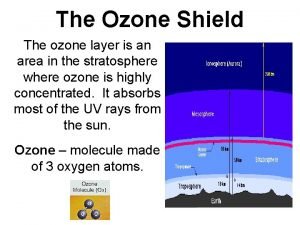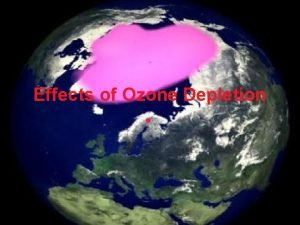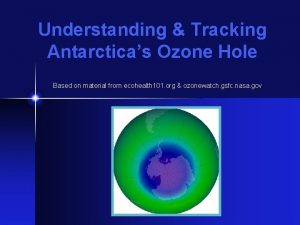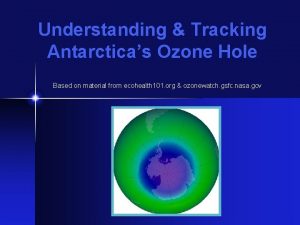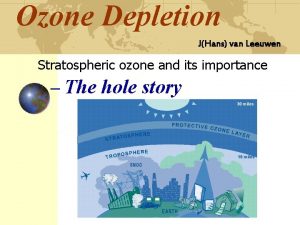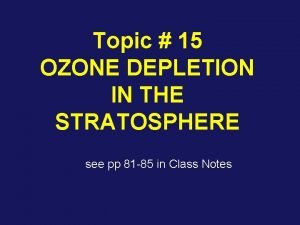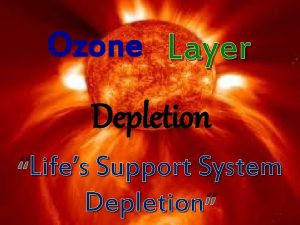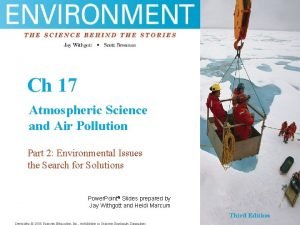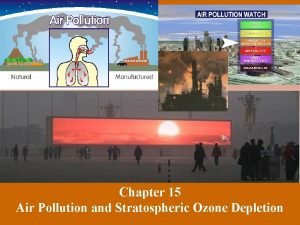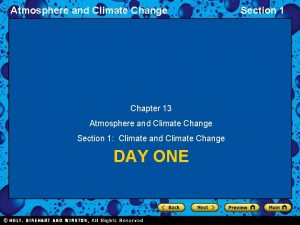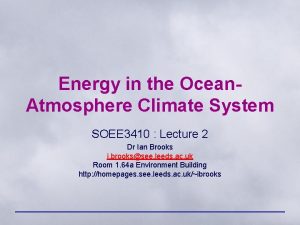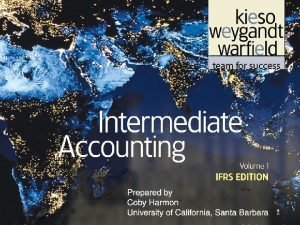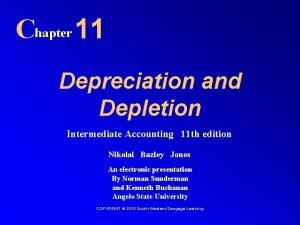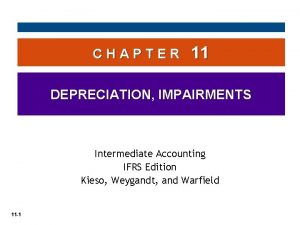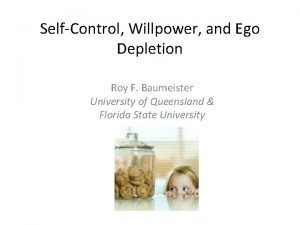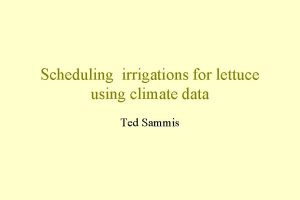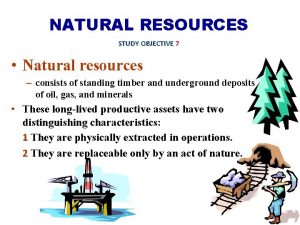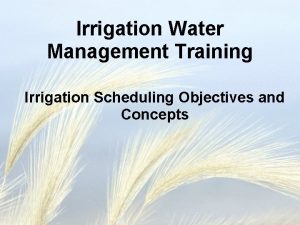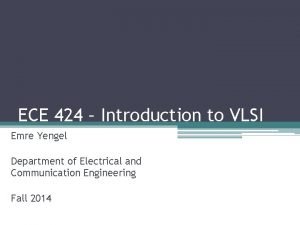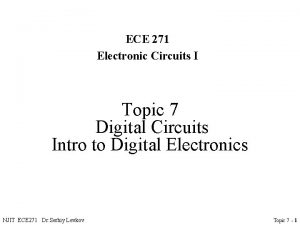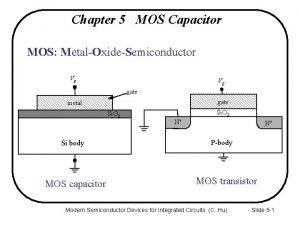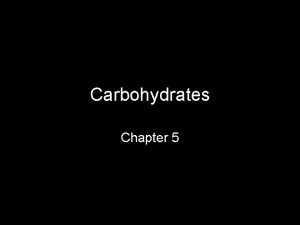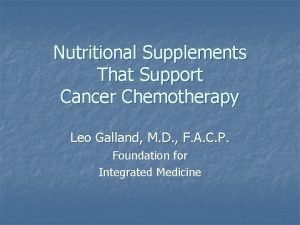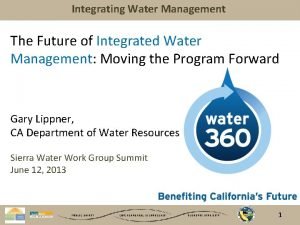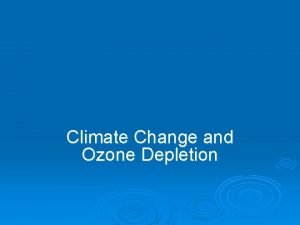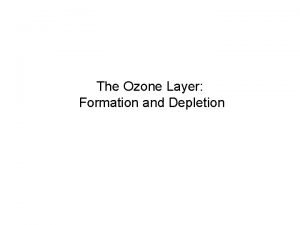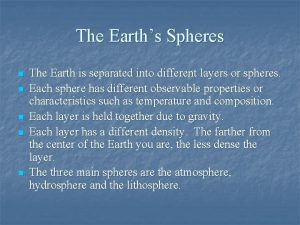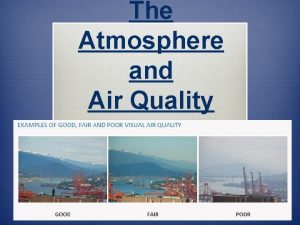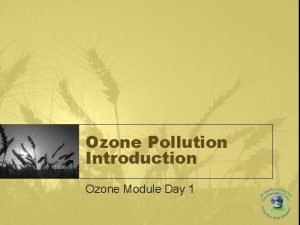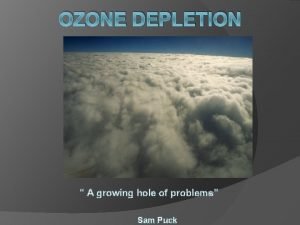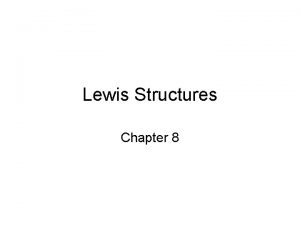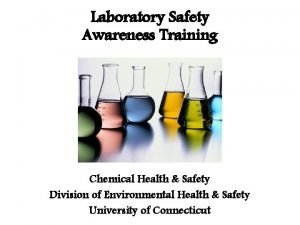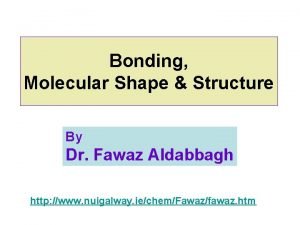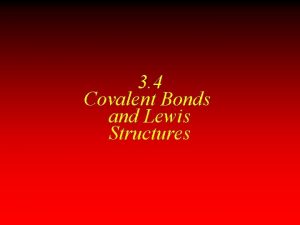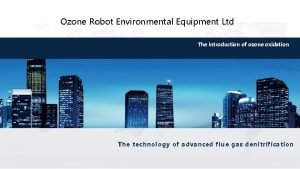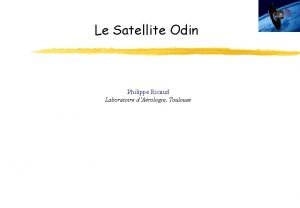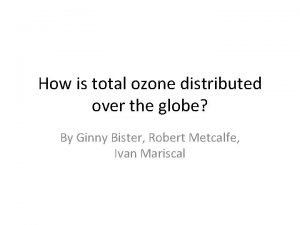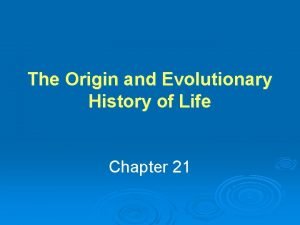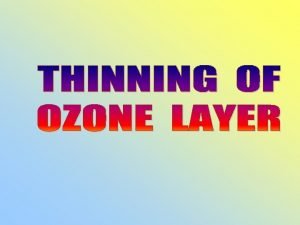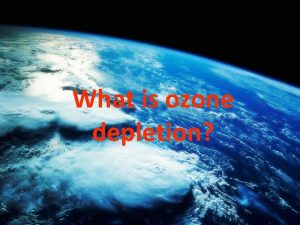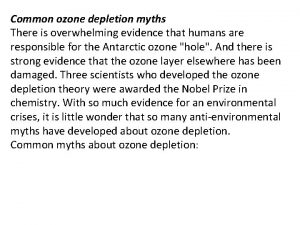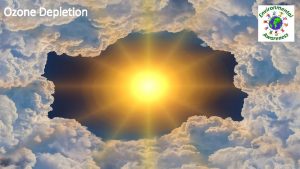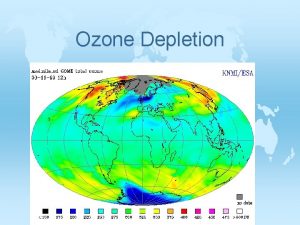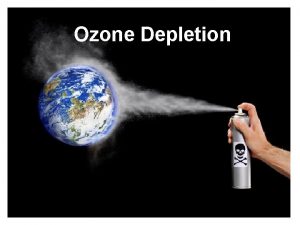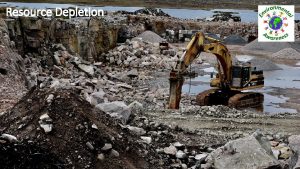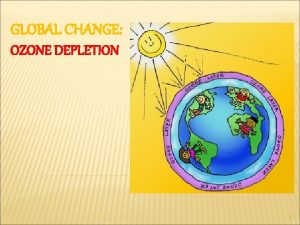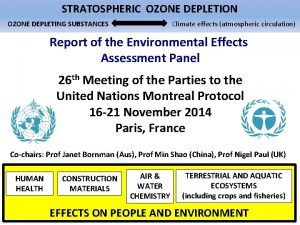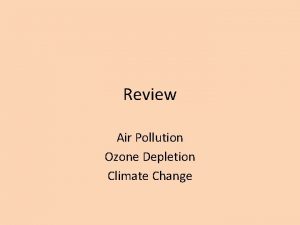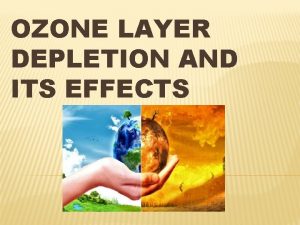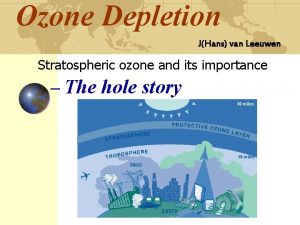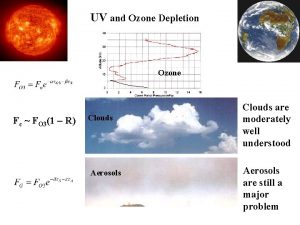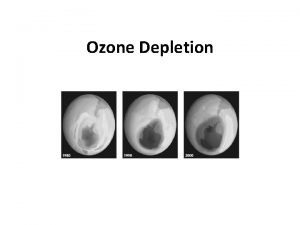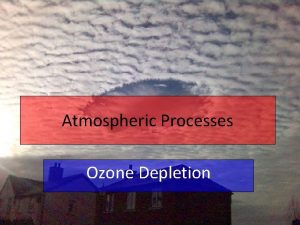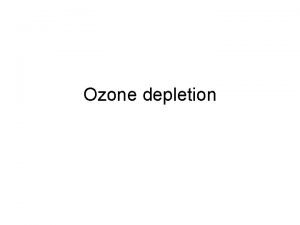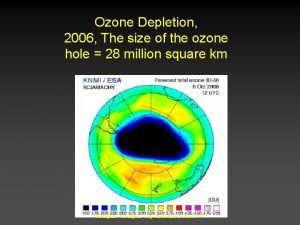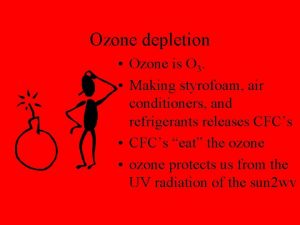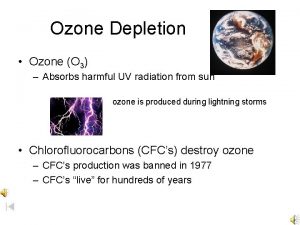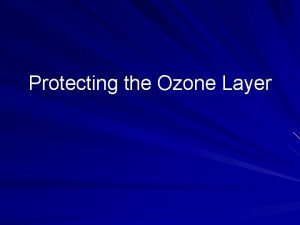The Atmosphere climate climate change and ozone depletion























































- Slides: 55

The Atmosphere climate, climate change, and ozone depletion Chapter 20

Hurricane Katrina • August 29, 2005 made landfall in the Gulf Coast east of New Orleans. • Day before was a category 5, by landfall was a category 4 (131 -155 mph winds). • Costliest storm ever: $80 billion in damage. • 1300 deaths in four states. • 1 of 27 named storms that year.

The cycle of storms • 2005 part of a multi-decade cycle of ideal conditions for spawning hurricanes. – Abnormally warm surface temps. – Low wind shear. • Studies suggest there is a link between global warming and hurricanes. – Links: atmosphere, oceans, human activities, and hurricanes.

Lesson 20. 1 ATMOSPHERE AND WEATHER

The Troposphere: • Area closest to Earth – Where weather occurs. – Moderates the flow of energy to Earth – Involved in the biogeochemical cycling of many elements and compounds. • Capped by the tropopause.

The Stratosphere • Above the tropopause • Temperatures increase with altitude • Little vertical mixing of air and no precipitation from it – Substances can remain there (trapped) for a long time. • Location of ozone layer • Capped by the stratopause

Gases of the Atmosphere • Most crucial gases – Oxygen – Nitrogen – Carbon – Sulfur – Water

Weather vs. Climate Weather Climate • Day-to-day variations in • Result of long-term weather temperature, air pressure, conditions. wind, humidity, and precipitation. • Mediated by the atmosphere. • The study of both weather and climate (atmosphere) is called meteorology.

Air currents Horizontal Vertical • As heat is radiated back • Air that must flow in to toward the atmosphere the replace the rising air causes gases near the Earth become horizontal airflow (wind). heated, expanding and rising. • Convection currents bring us the day to day changes in our weather as they move in a general pattern from west to east. • Rising air creates high pressure area in atmosphere and low pressure on Earth. • Winds tend to flow from high to low pressure regions.

Hadley Cell • The ultimate source of the horizontal flow is cooler air that is sinking and the recombination produces the Hadley cell.

Jet Streams • Earth’s rotation and air-pressure gradients generate “rivers” of air.

Fronts • Air masses of different temperatures and pressures meet at boundaries called fronts.

Lesson 20. 2 CLIMATE

Climate and biomes • The different temperatures and moistures in different parts of the world create the different ecosystems (biomes). – Tundra – Desert – Rainforest… • These reflect the different adaptations of plants, animals, and microbes that will be present.

Humans and climate • Humans can adjust to practically any climate (short of the brutal conditions of mountain tops or burning deserts) • Other organisms in a region are adapted to a particular climate and any major changes present a major threat to the structure and function of the existing ecosystem.

Since 1880… • Global average temperature has shown periods of cooling and warming, but the general pattern has increased 0. 8˚C (1. 4 ˚F)

Warming trends • There have been two warming trends in the 20 th century. – 1910 -1945 – 1976 -present

Proxies • Measurable records that can provide data on factors such as temperature, ice cover, and precipitation. – Additional proxies include: • • • Tree rings Pollen deposits Changes in landscape Marine sediments Corals Ice cores

Why warming then ice ages? • The most likely explanation for the major oscillations is the existence of known variations in Earth’s orbit. – Orbital configuration varies the amount of solar radiation over different continents and latitudes substantially. • These intervals take place according to several periodic time intervals called Milankovitch cycles. – 100, 000 years, 41, 000 yrs. And 23, 000 yrs.

Younger Dryas • Within the major oscillations of Milankovitch cycles are rapid climate fluctuations called Younger Dryas. – 10, 700 years ago the temperature in the arctic region rose 7˚C in 50 years! – Tremendous effect on living organisms

El Nino • Occurs when a major shift in the atmospheric pressure over the Central Equatorial Pacific Ocean leads to a reversal of the trade winds that normally blow from an easterly direction. • Warm water spreads to the east, the jet stream strengthen and shift from their normal courses, patterns in precipitation and evaporation are affected. • Most severe El Nino occurred 1997 -2000. – 1998 shifted to a La Nina. – Global damage approx. $36 billion, 22, 000 deaths.

La Nina • Reverse of El Nino: • Easterly trade winds are reestablished with even greater intensity, upwelling of colder ocean water in the eastern Pacific from the depths replaces surface water blown westward, the jet streams are weakened, and weather patterns are again affected.

Thermohaline • Refers to the effects that temperature and salinity have on the density of water. • Conveyer like system – Salty water from the Gulf stream is carried northward on the surface and is cooled by the arctic air currents. Cooling increases density of the water, which then sinks to depths of 4, 000 m (the North Atlantic Deep Water NADW). This deep water spreads southward where it is joined by the northward Antarctic waters.

Thermohaline

Thermohaline • When the conveyer is interrupted, climate changes abruptly. • North Atlantic marine sediments show evidence of the periodic invasion of icebergs from the polar ice cap that supplied huge amounts of fresh water as they melted-called Heinrich events.

Lesson 20. 3 GLOBAL CLIMATE CHANGE

Factors affecting climate Internal • Oceans • Atmosphere • Snow cover • Sea ice External • • Solar radiation Earth’s rotation Slow changes in orbit Gaseous makeup of the atmosphere

Greenhouse Effect • The interior of a car heats up when the car is sitting in the Sun with the windows closed. Sunlight comes through the windows and is absorbed by the seats and other interior objects thus converting light energy to heat energy in the form of Infrared radiation. “IR” is trapped by the glass and cannot leave the car, causing the internal temperature to rise. • Earth’s “glass” is the CO 2, water vapor, and other gases in the atmosphere.


Greenhouse gases • Greenhouse effect was first recognized by Jean-Baptiste Fourier in 1827. • Without greenhouse gases the Earth would be too cold to inhabit. • Ozone in the troposphere has a positive forcing effect (leads to warming). – Negative forcing leads to a cooling effect.

IPCC • Intergovernmental Panel on Climate Change. • 1988, Established by the UN Environment Program and World Meteorological Society. • Established three working groups: – One to assess scientific issues (working group I) – One to evaluate the impact of global climate change and the prospects for adapting to it (working group II) – A third to investigate ways of mitigating the effects (working group III) • Groups consist of more than 2000 experts in appropriate fields from over 100 countries. • The work of the IPCC has been guided by 2 basic questions: – Risk assessment: Is the climate changing and what is the impact on society and ecosystems? – Risk management: How can we manage the system through adaptation and mitigation?

IPCC findings: • January 2001 third assessment released – Bullets on pages 517 -518 • February 2007 fourth assessment released by group I – Global climate change is now occurring, it is an outcome of the rising levels of anthropogenic greenhouse gases, and the global impacts of the expected future changes will be unprecedented and severe

Carbon Sinks • Areas that absorb CO 2 and keep it from accumulating at a more rapid rate in the atmosphere. – Oceans (uptake of CO 2 by phytoplankton) – Terrestrial biota – See figure 20 -11 on page 520

The greenhouse gases • Most abundant – Water vapor • Concentration in the atmosphere is quite variable • Rapid turnover in the lower atmosphere • Does not accumulate over time (unlike the other gases) • Other greenhouse gases – Methane (CH 4) – Nitrous oxide (N 2 O) – Chlorofluorocarbons

ACIA • Arctic Climate Impact Assessment • 300 scientists and elders from six indigenous communities, funded by the National Science Foundation and the National Oceanic and Atmospheric Administration • Published in November 2004 • Key findings (bullets pages 528 -529)

Lesson 20. 4 RESPONSE TO CLIMATE CHANGE

Responses to climate change 1. Adaptation: we must anticipate some harm to natural and human systems and should plan adaptive responses to lesson the vulnerability. 2. Mitigation: take action to reduce emissions • Skeptics base their arguments on the fact that we don’t know much about the role of oceans, clouds, biota, and the chemistry of the atmosphere.

FCCC • Framework Convention on Climate Change • Document signed by the heads of state at the UNCED Earth Summit in Rio de Janeiro in 1992 • Agreed to goal of stabilizing greenhouse gases in the atmosphere starting by reducing greenhouse gas emissions to 1990 levels by 2000.

FCCC • Proposed three principle: – Precautionary principle: though we may not know for sure, we must take action just in case. – Polluter pays principle: polluters should pay for the damage their pollution causes. – Equity principle: The richest produce the most CO 2 and therefore should be the ones taking the action for the consequences paid by all.

Kyoto Protocol • Third conference of parties to the FCCC met in Kyoto, Japan in December 1997 to create an agreement on reducing greenhouse gases • 38 nations agreed to reduce emissions of 6 GHG’s to 5% below 1990 levels by 2012. – Signers have a lot of flexibility on deciding how to meet the goals. – Kyoto expires in 2012

UN climate Control Conference • Agreed on two things: – There will be future meetings to produce new, tougher set of binding limits on GHG’s that will take effect after 2012. – Broader dialogue towards reaching nonbinding accords addressing global climate change. • George W. Bush opposes Kyoto for two reasons: – It exempts the developing countries (unfair) – Cause serious harm to US economy

GCCI • February 2002 • Global Climate Change Initiative • Reduction of 18% in emissions intensity (ratio of GHG emissions to economic output) over the next 10 years

CCSP • July 2003, Bush administration report • Climate Change Science Program – Put sharper image on the government’s approach to climate research. – Seeks to address a number of issues in climate science, such as the natural variability in climate

NCCTI • National Climate Change Technology Initiative • Provides support for research and analysis of GHG’s and technologies to lower GHG emissions.

Likely consequences • Crop yields are likely to be reduced in tropical and subtropical areas • Water is likely to become more scarce in many regions already suffering • Increased heat and moisture in many regions leading to increased infectious disease and potentially lethal heat waves • Increased intensity and frequency of storm events (flooding)

Lesson 20. 5 DEPLETION OF THE OZONE LAYER

Ozone Layer • Protects Earth from harmful ultraviolet radiation. • Depletion mainly caused by human technologies, specifically the CFC’s • Read table 20 -5 on page 534. • Because the ozone layer blocks out more than 99% of the UV radiation it is commonly referred to as the Ozone Shield.

Formation of Ozone • Formed in the stratosphere when UV radiation acts on oxygen molecules. The high-energy UV radiation first causes some molecular oxygen (O 2) to split apart into free oxygen (O) atoms and these then combine with molecular oxygen to form ozone (O 3)

CFC’s • A type of halogenated hydrocarbon • Nonreactive, nonflammable, nontoxic organic molecules in which both chlorine and fluorine atoms have replaced some hydrogen atoms. • Under modest pressure, they liquefy giving off heat in the process and becoming cold. • Used as refrigerants, production of plastic foams, electronic industry for cleaning computer parts and as the pressurizing agent in aerosol cans.

CFC’s Safe? • CFC’s would be stable in the troposphere, but in the stratosphere they would be subject to intense UV radiation, which would break them apart, releasing free chlorine atoms via CFCl 2 + UV Cl + CFCl 2 – Chlorine acts as a catalyst to the break down of ozone.

Ozone hole • Fall 1985, British scientists working in Antarctica reported a “hole” in the stratospheric ozone layer. – The hole was actually a serious thinning. – Area the size of the US where ozone levels are less than 50% (of normal) – The hole was not discovered earlier by NASA because the computers were set to reject data showing a drop larger than 30%.

Polar Vortex • Winter in the Antarctic (June). • A whirlpool like vortex which confines stratospheric gases within a ring of circulation air. • The cloud of particles provide surfaces on which chemical reactions release molecular Chlorine. • When summer arrives, the sun’s warmth breaks up clouds and UV radiation attacks the molecular Chlorine initiating the Chlorine cycle which rapidly destroys ozone.

Arctic Hole? ? • • NO Higher temperatures Weaker vortex Ozone depletion has occurred, but only at 25% loss in especially cold winters.

Ozone depletion • Worldwide network on ozone measuring stations • Data sent to the World Ozone Data Center in Toronto, Canada • Depletion levels of 3% and 6% over the period 2002 -2005 in midlatitudes of the Northern and Southern hemispheres respectively.

Montreal Protocol • 1987, UN convened in Montreal Canada • Goal: address ozone depletion • Members reached an agreement called the Montreal Protocol – Scale CFC production back 50% by 2000. – To date 184 countries (including the US) have signed – Because Ozone losses were greater than expected, an amendment was adopted in June 1990. • Phase out major CFC chemicals by 2000 (developed and 2010 (developing) – Another amendment November 1992 • Complete CFC phaseout by January 1, 1996
 Negative effects of ozone depletion
Negative effects of ozone depletion Ozone depletion effect on humans
Ozone depletion effect on humans Causes of the ozone depletion
Causes of the ozone depletion Ozone layer depletion introduction
Ozone layer depletion introduction Stratospheric ozone depletion
Stratospheric ozone depletion Ozone depletion diagram
Ozone depletion diagram Global warming vs ozone depletion
Global warming vs ozone depletion Protective ozone layer
Protective ozone layer Ozone layer levels
Ozone layer levels How is smog formed
How is smog formed Climate change 2014 mitigation of climate change
Climate change 2014 mitigation of climate change Atmosphere
Atmosphere Chapter 13 atmosphere and climate change
Chapter 13 atmosphere and climate change Ocean smallest to largest
Ocean smallest to largest Ocean atmosphere and climate
Ocean atmosphere and climate Which method is used to compute depletion?
Which method is used to compute depletion? Chapter 11 depreciation impairments and depletion
Chapter 11 depreciation impairments and depletion Kunci jawaban buku intermediate accounting ifrs chapter 11
Kunci jawaban buku intermediate accounting ifrs chapter 11 Climate change meaning
Climate change meaning Roy baumeister ego depletion
Roy baumeister ego depletion Lettuce scheduling
Lettuce scheduling Depletion formula
Depletion formula Objectives of irrigation
Objectives of irrigation Nmos inverter with depletion load
Nmos inverter with depletion load Ece 271
Ece 271 Role of wildlife conservation
Role of wildlife conservation Ch14 twitch
Ch14 twitch Mosfet accumulation depletion inversion
Mosfet accumulation depletion inversion Depletion
Depletion Depletion
Depletion Tamoxifen nutrient depletion
Tamoxifen nutrient depletion Resource depletion
Resource depletion Depletion
Depletion Determining the cost of plant assets
Determining the cost of plant assets P
P How do cfcs destroy ozone
How do cfcs destroy ozone Protective ozone layer
Protective ozone layer Ozone composition
Ozone composition Sopmed training
Sopmed training Atmega44
Atmega44 Protective ozone layer
Protective ozone layer Ozone layer simple definition
Ozone layer simple definition The ozone blanket blocks
The ozone blanket blocks Ozone lewis structure
Ozone lewis structure Chemical sensitivity symptoms
Chemical sensitivity symptoms Examples of non linear molecules
Examples of non linear molecules Ncnh2 lewis structure
Ncnh2 lewis structure Ozone robot
Ozone robot Philippe odin
Philippe odin How is total ozone distributed over the globe
How is total ozone distributed over the globe How ozone forms
How ozone forms Ozone layer made up of
Ozone layer made up of Protection of ozone layer
Protection of ozone layer Vray sun settings
Vray sun settings Ozone without borders
Ozone without borders Ozone hole myth
Ozone hole myth
